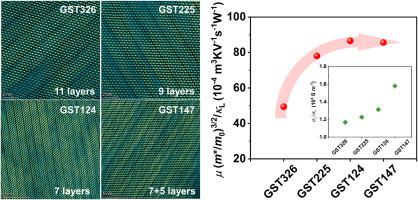当前位置:
X-MOL 学术
›
Mater. Today Phys.
›
论文详情
Our official English website, www.x-mol.net, welcomes your
feedback! (Note: you will need to create a separate account there.)
Structural evolution and thermoelectric performance in (GeTe)m(Sb2Te3)n compounds
Materials Today Physics ( IF 10.0 ) Pub Date : 2024-05-09 , DOI: 10.1016/j.mtphys.2024.101455 Shuo Chen , Keke Liu , Tingting Luo , Lin Liao , Zhen Yang , Shenlong Zhong , Jinsong Wu , Xianli Su , Pierre Ferdinand Poudeu Poudeu , Qingjie Zhang , Xinfeng Tang
Materials Today Physics ( IF 10.0 ) Pub Date : 2024-05-09 , DOI: 10.1016/j.mtphys.2024.101455 Shuo Chen , Keke Liu , Tingting Luo , Lin Liao , Zhen Yang , Shenlong Zhong , Jinsong Wu , Xianli Su , Pierre Ferdinand Poudeu Poudeu , Qingjie Zhang , Xinfeng Tang

|
Exploring the relationship between crystal structure and thermoelectric performance is a pivotal topic in the thermoelectric field. In this study, we have comprehensively investigated the correlation between the structural evolution of (GeTe)(SbTe) pseudo-binary system and the thermoelectric properties. The proportion of van der Waals bonds increases with the rising SbTe content, resulting in an increase in the anisotropy of the electrical conductivity and a decrease in the average sound velocity. Additionally, the cation sites in the crystal lattice of these compounds exhibit a mixed occupancy of Ge/Sb atoms, although the cation sites adjacent to the van der Waals gaps are predominantly occupied by Sb atoms. The ultra-low lattice thermal conductivity of the GST124 and GST147 compounds is mainly attributed to the high concentration of van der Waals bonds and enhanced phonon scattering arising from Ge/Sb mixed cation occupancy and high density of defect structures. The high electrical conductivity combined with the low lattice thermal conductivity enables GST124 and GST147 compounds to achieve a maximum value of 0.56 and 0.57, respectively. Higher thermoelectric performance can be achieved through optimization of the microstructure as well as the carrier concentration.
中文翻译:

(GeTe)m(Sb2Te3)n 化合物的结构演化和热电性能
探索晶体结构与热电性能之间的关系是热电领域的一个关键课题。在本研究中,我们全面研究了(GeTe)(SbTe)赝二元体系的结构演化与热电性能之间的相关性。随着SbTe含量的增加,范德华键的比例增加,导致电导率各向异性增加,平均声速降低。此外,这些化合物晶格中的阳离子位点表现出Ge/Sb原子的混合占据,尽管与范德华间隙相邻的阳离子位点主要被Sb原子占据。 GST124和GST147化合物的超低晶格热导率主要归因于高浓度的范德华键以及Ge/Sb混合阳离子占据和高密度缺陷结构引起的增强的声子散射。高电导率与低晶格热导率相结合,使 GST124 和 GST147 化合物的最大值分别达到 0.56 和 0.57。通过优化微观结构和载流子浓度可以实现更高的热电性能。
更新日期:2024-05-09
中文翻译:

(GeTe)m(Sb2Te3)n 化合物的结构演化和热电性能
探索晶体结构与热电性能之间的关系是热电领域的一个关键课题。在本研究中,我们全面研究了(GeTe)(SbTe)赝二元体系的结构演化与热电性能之间的相关性。随着SbTe含量的增加,范德华键的比例增加,导致电导率各向异性增加,平均声速降低。此外,这些化合物晶格中的阳离子位点表现出Ge/Sb原子的混合占据,尽管与范德华间隙相邻的阳离子位点主要被Sb原子占据。 GST124和GST147化合物的超低晶格热导率主要归因于高浓度的范德华键以及Ge/Sb混合阳离子占据和高密度缺陷结构引起的增强的声子散射。高电导率与低晶格热导率相结合,使 GST124 和 GST147 化合物的最大值分别达到 0.56 和 0.57。通过优化微观结构和载流子浓度可以实现更高的热电性能。

































 京公网安备 11010802027423号
京公网安备 11010802027423号